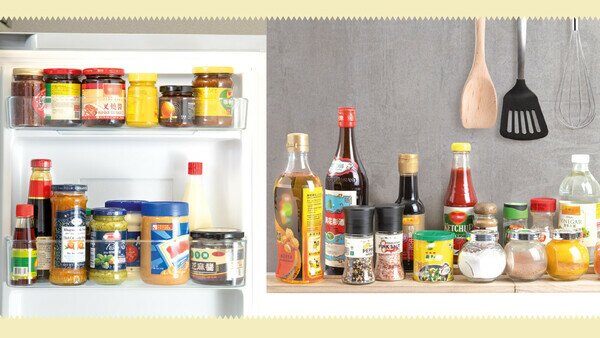Sauce and condiments are considered as the must have “seven necessities” of traditional Chinese households. However, the local hot and humid climate could perish them if stored improperly, resulting in a waste of food to gastrointestinal upset. Prolonged consumption of spoiled food with mycotoxins might even increase the risk of cancer. The Consumer Council reminds consumers on the best way to store sauce and condiments based on their main ingredients, nature and ways of use so that consumers can eat at ease.
Different households have their own habits to store sauce and condiments. Some would have them kept in the kitchen cabinets while others would prefer to store them in the refrigerators altogether after opening to avoid spoilage. In fact, either way has its own drawbacks. Some kinds of condiments should not be stored in refrigerators due to the nature of ingredients. Dry condiments such as salt, sugar, garlic salt, chicken powder, tapioca starch, pepper and dehydrated, grinded or whole spices ought to be stored in sealed containers and be kept in cool dry place. If they are stored in refrigerators and taken out afterwards, they would absorb moisture from the air due to temperature difference. As for cooking oil, it would become solidified or cloudy at low temperature. Repeated retrieval from the refrigerator and placed in room temperature might form water droplets inside the container which becomes a breeding ground for bacteria. Consumers should instead buy small bottle size or have the cooking oil transferred to a small bottle and kept it in a shaded and cool place. It is also suggested to be consumed within 2 months.
Soya bean-based condiments such as fermented soya beans and soya bean paste would accelerate fermentation after opening and lead to an alteration of taste and colour. They should be kept in refrigerators. As for salted or fermented condiments such as shrimp paste and fish sauce, given they are rich in salt and usually consumed over a long period of time, most manufacturers would suggest keeping them in refrigerators after opening to avoid spoilage or becoming mouldy due to the hot and humid environment. For the same reason, oyster sauce, char siu sauce and other sauce with rich water content are better to be stored in refrigerators after opening. Also suggested with the same means of storage are condiments with spices (e.g. chili sauce, chili oil, XO sauce, curry sauce), peanuts (e.g. shacha sauce), egg (e.g. mayonnaise), milk (salad dressing) or fruits and vegetables (e.g. jam) as their ingredients could be perished easily and moulds could survive well in low water context food.
Although soya sauce is also produced as a result of fermentation of soya beans, it could be kept in cool dry place if used frequently due to its high salt nature, making it difficult to get rotten. In contrast, if consumes over a long period of time, it is better to be stored in refrigerators to avoid becoming mouldy under hot and humid weather.
Alcohol and acetic acid could inhibit bacterial and mould growth, thus, condiments with high concentration of alcohol or vinegar could just be kept in cool dry place. However, for flavoured wine and vinegar which might be mixed with other ingredients, the concentration of alcohol and acid will be inevitably lowered and as such they should be kept in refrigerators after opening. For ketchup, as tomato is naturally acidic and vinegar is added to increase its acidity, quick consumption within 2 weeks after opening could allow the ketchup to be kept at room temperature.
Consumers should refer to the following apart from the specific suggestions listed on products labels:
- The terms “USE BY” and “BEST BEFORE” printed on packaging have different meaning. For condiments yet to open but passed the ‘USE BY” date, even they look and taste as normal, food poisoning microorganisms and toxins produced might have already existed. In contrast, for most condiments that yet to open but passed the “BEST BEFORE” date, while some of the quality may be deteriorated, they are still edible;
- If mould is found in condiments, the whole bottle should be discarded and not to be consumed. Even all moulds that could be observed just by naked eyes are removed, the root of the moulds may have penetrated deeply inside the food and whether the mycotoxins have spread in the whole bottle could not be judged. Consumers might suffer gastrointestinal upset upon consuming food with moulds. Excessive intake or a prolonged intake of certain mycotoxins might even increase the risk of cancer. Children, elderly and chronic disease patients whose immune system is weaker, an intake of mouldy food might result in acute infection or even death;
- Condiments should only be retrieved with dry and clean utensils. Dry tissues should be used to cleanse the exterior packaging or bottle cap thoroughly to ensure no condiments left. Bottle cap must be fastened afterwards;
- Condiments should be kept away from the stoves as far as possible. The temperature near the hot stove is higher, leading to faster oxidation of oil content inside condiments for bacterial growth. Moreover, steam produced during cooking could moisturize the condiments and provide a favourable condition for mould growth which releases mycotoxins;
- Consumers should consider purchasing small-sized packaging of condiments or have them transferred to small bottles for use. Consume them all as soon as possible after opening not only reduce the health risk posed by food spoilage but also to prevent wastage so as to support sustainable consumption.
The Consumer Council reserves all its right (including copyright) in respect of CHOICE magazine and Online CHOICE.



